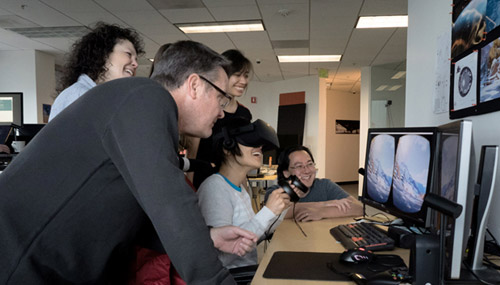Entertainment
Fusing Virtual with Reality
By Melody Yuan

How to stay ahead in the virtual reality industry that’s about to hit critical mass.
Virtual reality (VR): a simulated, augmented, interactive and sensory experience that transports users to another dimension.
And it’s finally being immersed into reality.
The Experience
Once the VR headset has been secured and you open your eyes, nothing can hold you back. Immerse yourself in a place where the world is your canvas with Google’s newest VR app, Tilt Brush. Jump on a wild roller-coaster ride where you’re battling alien battleships on Six Flags’ newest ride, The New Revolution. Practice surgical procedures without putting patients at risk with SimSurgery AS’ comprehensive VR laparoscopy. Experiences in the virtual world are becoming increasingly sophisticated with advancements in technology, integration and accessibility.
While the concept of escapism through the means of advanced technology isn’t new, the actual development of this technology and its implementation into the everyday lives of consumers is just beginning, and this phenomenon is spreading across the world.
The Journey
Investment into virtual reality just hit $1.1 billion in 2016 and every industry, from entertainment to health care, is looking for ways to leverage this new technology. Of the total investment amount, Magic Leap Inc. raised $800 million, backed by large and powerful companies with clout such as Alibaba Group Holding Ltd. and Google. Goldman Sachs predicts that the industry may become an $80 billion market by 2025.
“I was doing VR research in grad school 20 years ago — literally, in 1996,” says Larry Cutler, advisor to Baobab Studios Inc., a VR animation studio that tells animated stories in Redwood City, Calif. “It’s been around for a while, but basically what’s happened is that through the waves of computing, technology has improved, and with bigger companies like Facebook purchasing Oculus VR and investing billions of dollars, the industry has picked up business momentum. All this stuff you’re seeing is still very primitive, but I think it now makes business sense for companies to create VR content and integrate it into our everyday lives.”
Bennett Pozil, executive vice president and head of corporate banking at East West Bank believes, “VR distribution should reach beyond the entertainment industry and explode into our daily lives. While we should first experience the rise of VR from a social entertainment perspective... VR applications should also expand into education, engineering and communication sectors.”
The Challenge
Big companies like Sony Corp., which makes the PlayStation; Facebook; HTC Corp. and Samsung have created various competing virtual reality prototypes to sell. In China, dozens of tech companies, such as DeePoon, 3Glasses, AntVR and Baofeng Tech are offering comparable VR headsets and technology for competitive prices. Pozil is well connected in the entertainment and digital industries across the Pacific. “I’ve had the opportunity to meet with VR industry professionals in the U.S. and China and am very impressed with the knowledge, experimentation and direction coming from both continents.” With so many companies bidding and vying for a spot in this growing industry, is the market becoming fragmented? How should consumers and developers navigate this space?
“There are so many great ways that VR can be brought out to the consumer,” says Chris Hewish, head of studio for Survios Inc. in Culver City, Calif. “We’re in the soft launch phase right now, where everyone’s experimenting. We have mobile-, console- and PC-based VR — all of which create different experiences for the user.”
Regardless of which platform or technology is being used, the biggest distinguishing factor is the content. “Create a story that can be featured on each of these different platforms,” Cutler says, “maximize their strengths and minimize their weaknesses to see what really resonates with audiences to then more accurately build a strategy.”

"Create a story that can be featured on different platforms"
As the VR market becomes increasingly saturated and competitive, developers and companies must identify ways to hook audiences across multiple platforms and devices. “In the short term, it’s much more about creating the best content for the most exposure,” says Cutler. “Make a mark now for when business models are clearer in the future.”
Accurate and extensive market research will be necessary to reach target demographics and stay ahead of the curve. On the flip side, consumers must commit to the platforms, devices, games and storylines that resonate best without feeling overwhelmed.
The Return
Because the VR industry is still in its nascent stage, a business model that results in a revenue stream and investment returns has yet to materialize. Through the many phases of trial and error, one company has emerged to take the helm on VR advertising. “For us, the most important thing is for the platform and content to be successful and for the users to love VR and have good experiences,” says Christine Lee, vice president of business for Immersv Inc., a VR startup in Emeryville that just revealed its advertising platform. “The way that we’ve integrated ads is always through something that the user opts into or has some kind of value exchange.” With a team that has extensive experience in mobile advertising, Immersv understands what clicks with users and what doesn’t. As a testament, their company has seen ad viewing completion rates of 80 percent — about double the rate of mobile ads. “We’re constantly doing A/B testing to make sure that it’s an experience that users like and that they have full control.”
Immersv has also been successful in collecting data and tracking analytics, like conversion and engagement rates, to accurately identify how users are responding. With regards to whether VR advertising will become as ubiquitous as TV or YouTube ads, Lee says, “I hope that advertising in VR has a low frequency for the sake of the industry. It truly should be a service for users to discover other content in a seamless way.” In order to develop, integrate and fine-tune great advertising content, Lee calls on developers and consumers to provide as much feedback as possible to companies and to one another.
"For us, the most important thing is for the platform and content to be successful and for the users to love VR and have good experiences. "

Besides advertising, companies also want to entice users to purchase goods within the virtual reality experience. Whether it comes in the form of a purchase that helps the user advance faster through a game or virtually shopping with your favorite fashion bloggers, companies are finding creative ways to get users to pay for play.
The Future
So where is VR headed?
“Right now, in terms of accessibility, mobile is the market and gateway to consumers,” says Lee. “We’ll see by the end of the year what’s happening with big platforms like Sony, Facebook and HTC, because by next year, I’m sure these players are going to want something else and it’s going to shake up the market even more.”
Developers must find innovative ways to get ahead of the VR race. “Right now is a unique opportunity for developers to plant their flag in the ground,” says Hewish. “This will either give them a lead in the market or create equity in their product, which the big companies may purchase later when they’re on board.”
With a better price point, improved experience and easier accessibility, the future of VR looks promising. The technology is set to grow across various industries around the world, with projects ranging from NASA partnering with Sony’s PlayStation to create a VR space-training program to RYOT Corp. creating a VR documentary focused on Syrian refugees from Aleppo. Given the fact that VR is becoming increasingly integrated, Hewish warns developers and businesses that, “the early adopter, tech model phase is going to pass by very quickly, and it’s going to be very painful for a lot of people who don’t evolve past that.”
In terms of concerns about VR changing the way humans interact and function as a society, Cutler believes that “there’s always been a stigma attached to the words ‘virtual reality.’” Although the blurring lines between the digital world and real life may be the leading cause for resistance against consumer adoption, Cutler remains optimistic. “Let’s go back to previous platforms: PCs and social media were thought to be isolating, yet Facebook is the largest social network on the planet, which connects people through PC. I think VR forges a similar opportunity and actually takes it to the next level.” The fact that Facebook’s founder and CEO, Mark Zuckerberg purchased Oculus is a sign to many that the future of VR will redefine social experiences.
Exciting would be the word that most accurately describes the current VR landscape. “I see VR experimentation into the delivery of live events for commercial and entertainment use, plus the study of concepts for industrial and educational purposes,” says Pozil of East West Bank. “It’s the latter that may have the largest impact worldwide from the advent of the technology.”
While the VR industry is still in its early stages, developments are happening fast. Although the future is uncertain, investors, businesses, developers and consumers can all anticipate one thing: The cat is out of the box, and VR is here to stay. There will be people who resist this new and immersive technology that fuses virtual with reality, but those who embrace this change and find ways to enhance the technology for their purposes will come out ahead of the game.
Sign up for the Reach Further Newsletter
We’ll keep you in the know about the latest US-Asia business news and trends.
Suscríbase al boletín Reach Further
Lo mantendremos informado sobre las últimas noticias y tendencias comerciales entre Estados Unidos y China.

